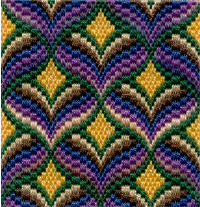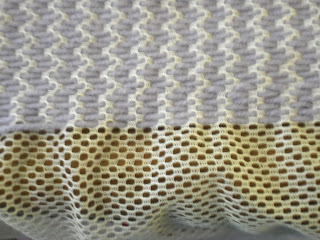Here are some of the basic patterns for weaving the length of the mesh.
These four are made by choosing to weaving up or down in the first hole of the row and then weaving up and down in each hole of the row going up.
I will be writing these patterns working from right to left.
The red downward diagonal (working from right to left) is made like this:
Work down in the first hole of the first row.
Work up in the first hole of the second row.
Work up in the first hole of the third row.
Work down in the first hole of the fourth row.
Work down in the first hole of the fifth row.
Repeat 2 ups and 2 downs to form the pattern.
The green chevron (working from right to left) is made like this:
Work down in the first hole of the first row.
Work down in the first hole of the second row.
Work up in the first hole of the third row.
Work up in the first hole of the fourth row.
Work up in the first hole of the fifth row.
Work down in the first hole of the sixth row.
Work down in the first hole of the seventh row.
Work down in the first hole of the eighth row.
Work up in the first hole of the ninth row.
Work up in the first hole of the tenth row.
Work up in the first hole of the eleventh row.
Work down in the first hole of the twelfth row.
Alternate 3 ups and 3 downs to form the pattern.
The red upward diagonal (working from right to left) is made like this:
Work down in the first hole of the first row.
Work down in the first hole of the second row.
Work up in the first hole of the third row.
Work up in the first hole of the fourth row.
Work down in the first hole of the fifth row.
Work down in the first hole of the sixth row.
Repeat 2 downs and 2 ups to form this pattern.
The blue zig-zag (working from either direction) is made like this:
Go down in the first hole of every row.
These are the basics. There are a few special patterns that we can play with, but most of the old patterns and probably the ones you are likely to use the most will have one or a combination of these basics.
Thanks for visiting with me.
Kathi Linz

















































